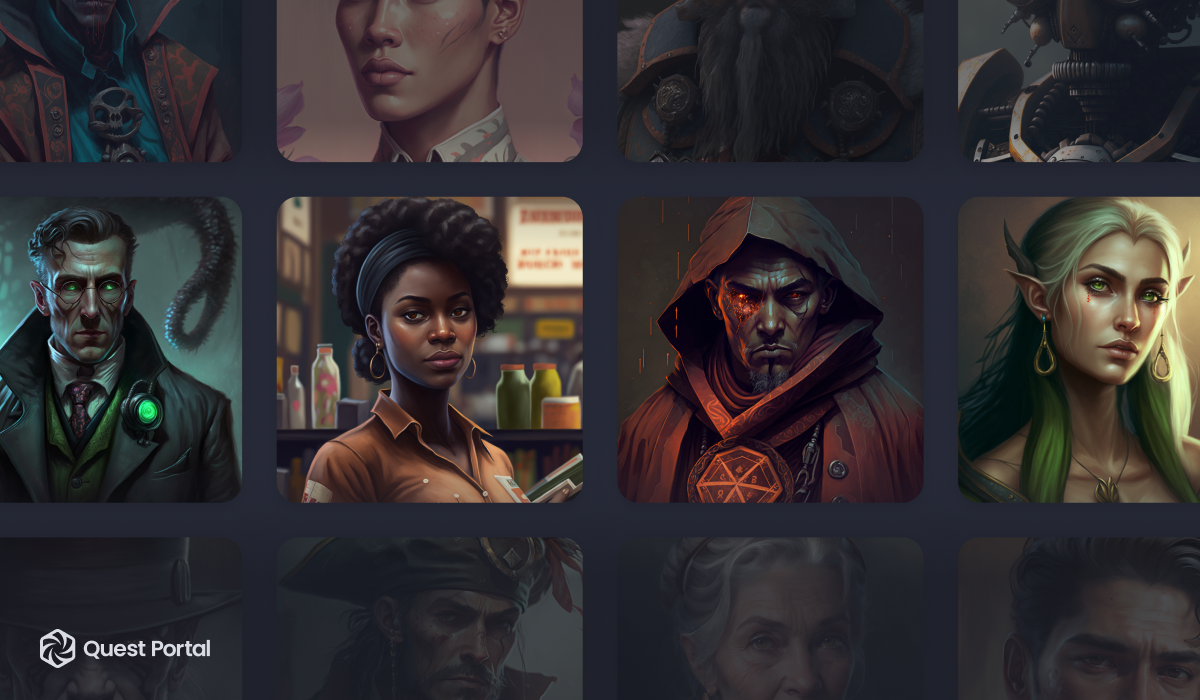Jump to section

Gunnar
Apr 20, 2023 · 12 min read
Create Epic Characters For Your Next TTRPG
character creation
ttrpgs

You approach the mysterious tavern at the edge of town. As you open the weathered door, one question enters your mind…WHO THE HECK AM I?! Creating an incredible character for your next TTRPG can feel overwhelming. There are endless systems to choose from and so many choices to make even before your first roll. But fear not, dear adventurer! Whether you are creating a TTRPG character for your first campaign or are a seasoned player looking for a bit of inspiration, we have you covered with a helpful guide on creating characters from start to finish.
STEP ONE: Backstory basics
At most tables, backstories are used as fuel for the GM to create a connection between your character and the campaign they are creating. Backstories also deeply influence how your character interacts with the world and other characters around them. For example, are they afraid of the dark because they found a monster lurking under their bed, or does the smell of roses create fond memories of their late spouse?
Here are a few questions to spark inspiration while creating your backstory.
- How would you describe their demeanor when calm and under pressure?
- How do they carry themselves around friends, strangers, and authorities?
- What are they afraid of?
- What do they love?
- What are they searching for?
- Who will they betray in pursuit of their goals?
- What connects them to rest of the party?
- When were they at their happiest?
STEP TWO: Humble beginnings
All great and heroic tales must have a beginning. The characters we create at the table are no exception. When designing your backstory, it is important to consider the moments leading up to your adventure. To illustrate this point, let’s examine two of the most famous rouges –Robin Hood and Catwoman. These two may seem extremely similar on a character sheet with their high charisma, combat skills, and ability to pocket almost anything unseen. However, one is motivated by robbing the rich to give to the poor, whereas the other steals to survive. Even if they both existed within the same world, their motivations would drive them to make drastically different decisions. Establishing your past will give your character the stakes to propel their point of view. The world around them shapes this point of view, so don’t hesitate to reach out to your GM and learn more about the world they live in.
STEP 3: Ancestry and origins
Several TTRPGs allow you to play fantastical beings like elves, dwarves, birds, and even sentient blobs of slime. Playing these types of characters can be extremely rewarding because it forces us to think outside of ourselves and see the world through a completely different lens. Many TTRPGs will give you breakdowns of the cultures and origins of these characters. Use those as a roadmap but do not be afraid to veer off the path and go against written stereotypes. For instance, halflings were inspired by the Hobbits from the Lord of the Rings. They are typically gregarious and peaceful folks who love food and value the comforts of home. However, you can choose to play a gruff halfling mercenary that grew up in a seedy town known for gambling and unsavory affairs.
Using your culture can also be a wonderful way to add a personal touch to your ancestry and origins. Nothing says you cannot create an elf inspired by Desi culture or an Orc inspired by Norse mythology. Adding these details creates rich worldbuilding that goes beyond typical fantasy that is traditionally centered around European lore. The most important part of this is to be true to your character to avoid unnecessary real-world stereotypes.
In some games, ancestry is more than just cultural and includes biological differences like the ability to fly or keen night vision. These ideas can also be expanded upon to create interesting and memorable characters. For instance, if you are playing a bird folk or Aarakocra, what does it look like when you take flight? Do you have one wing that is bigger than the other, forcing you to always fly at an angle? Are you beautifully elegant upon landing, or are you like a puffin and constantly smash into the ground below? These small quirks can be extremely fun to plan and add unique depth to your character.
STEP 4: What’s in a name?
Now that you have a general vibe of your character–let’s name them! The name you choose can have a deep and metaphoric meaning. Or it can simply be a ridiculous pun or an inside joke that makes your table laugh. However, names can be the hardest part of character creation for some people. But luckily, there are a few great resources aimed to spark inspiration and help you find a name worthy of your hero. Check out babynames.com for a plethora of names and their meanings, or you can even generate your own in any genre with the fantasy name generator. While being precious with this step is tempting, try not to overthink it. Your character can be one of many names or even receive a nickname during the adventure. Once you name your character, you are another step closer to bringing them to life at your table.
STEP 5: Skills and attributes
Skills and attributes are the perks and actions your character can perform during the course of the game. These can vary from system to system, but many games share key attributes such as intelligence that add modifiers to your rolls. Simply put, these are the crunchy bits on the character sheet that help you do stuff! When creating your character, it is useful to consider why they are proficient in certain areas and not others. Did they have a mentor that taught them how to be a sharpshooter? Or did they attend a prestigious academy and were ranked highest in their class?
On the topic of class, many TTRPGs also have specializations or occupations to choose from. These systems offer skill perks that differentiate your character’s specialty from others at the table. For instance, a professor in Call of Cthulhu will receive perks in library use, psychology, and a few academic specializations. In contrast, private investigators receive perks in bargaining, fast talk, etc. For a deeper dive into creating characters in Call of Cthulhu, check out this article by our dear friend and resident Call of Cthuhlu enthusiast, Nik.
STEP 6: Physical descriptions and artwork
Describing your character’s appearance lets your artistic and creative side shine. What style of clothing do they wear? What physical attributes are the most memorable about them? A great way to draw inspiration for your character is to create a photo collection that matches the feeling you’d like to achieve. From there, you can commission a fantastic artist to bring them to life or utilize Quest Portal’s ultra simple ai-generated Avatar Creator. The Quest Portal avatar portrait generator is designed to create images specifically for TTRPGs and can be used earlier in the brainstorming process to spark inspiration. After selecting the options listed, write your character description (as detailed as you’d like) and hit generate. From there, you will receive six images to choose from. Select whichever makes you the happiest! Now you have an awesome hero (or villain) to share with your table to further immerse yourself into the story.
STEP 7: Items of value
In the words of the great Marie Kondo…does this spark joy? In the midst of epic adventure or solving spooky mysteries, what items does your character choose to carry with them and why. Considering this is a fantastic way to immerse yourself within your character's world further and gives you a sentimental attachment to your items beyond their practical use on your character sheet. For instance, if your character is a gunslinger, perhaps they carry a battle-worn pistol named “Sheila.” This same character could also carry a locket containing a photo of their daughter. While they are a grizzled gunslinger who takes pride in their prowess, they are fighting to keep their daughter safe in a world filled with violence. These small details tell us so much about the character. Moving beyond the character sheet and treating items as a reflection of your character is an easy way to ground them into the world. Here are a few questions to ignite your imagination.
- Who gave this item to your character?
- Was this item stolen?
- Was this item passed on through generations?
- Does the item have any symbolic meaning or arcane symbols?
- Of all the weapons in the world, why does your character choose this one?
- What connection does this item have to the world around you? For example, is it a standard weapon used by a particular group of people, or is it a sigil from a secret society?
STEP 8: Establishing relationships
The final touch for character creation is establishing their connection to the rest of the party. Starting a game with established connections will help you and your fellow players find why their characters care about each other, leading to more dynamic interactions. Playing a loner archetype works well in films where the audience can see that character's inner world. However, it is much more difficult to accomplish due to the nature of collaborative roleplaying games. So don’t be afraid to build your backstory with the rest of the table or find reasons why your characters have chosen to travel together.
However, some campaigns start at the very beginning, which can lead to the awkwardness of meeting each other for the first time. A fun trick around this is to work with the GM privately or publicly to learn more about the world, and potential connections characters could have, even if they do not know each other directly. For instance, are they members of the same faction, or is one character interested in studying the same arcane legend as you? Finding commonalities within games has the exact same effect as in the real world. Once common interests are established, roleplaying reasons why the party chooses to travel together becomes much easier.
Putting it all together
The characters we create stay with us long after their adventures end. As storytellers and gamers, they often become extensions of ourselves and the stories that excite us. The character you create can be inspired by your own culture or life experiences. Don’t be afraid to reach out to your GM about the things that inspire you no matter how small.
Quest Portal is a great place to collect your thoughts and build character. With our ai-powered avatar generator, you can create a gorgeous character portrait in minutes. Not only that, our notes feature allows you to write in-depth notes about your backstory and keep track of special moments within your session. Check it out for free at questportal.com. Have fun creating epic characters!